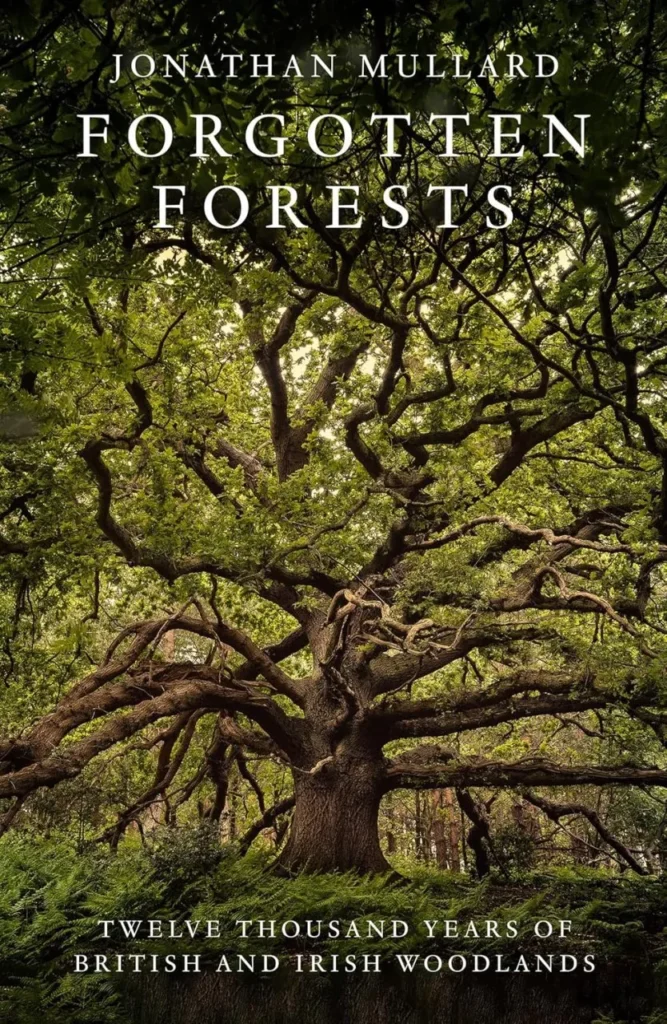Forgotten Forests
Jonathan Mullard

History meets natural history is probably the best way to sum up Jonathan Mullard’s new book about British and Irish woodlands over the last twelve thousand years. As there are so many books about trees and woodlands in these isles, a writer must identify and fill a gap. This book rises to, and emphatically answers, that challenge.
Although the interested reader is spoilt for choice when it comes to good books on trees and woodlands, it is fair to say that not all of them are what you would call page turners.
Academics often write books of great scholarship that are best treated as reference works, dipped into rather than read cover to cover. Forgotten Forests is a book that I found had me gripped from the beginning of the preface. The story is told in chronological order, and you get swept along by the desire to find out what happens next.
What is clear is that a lot of research, on wide-ranging subjects, has gone into this book. Of note is the evidence drawn from archaeology. The submerged remains of forests that were swallowed up by rising sea levels as Britain became separated from the Continent provide particularly compelling evidence of former forests. But it is the strength of the narrative that stands out. The story begins twelve thousand years ago as the ice retreats northwards to leave a land ripe for colonisation by the plants and animals that were forced to retreat as the climate cooled.
The value of character and the use of the story arc, in which drama rises to a climax followed by a resolution, is deployed to great effect. Historical figures and events are used to build a connection between people and forests. Even trees are treated as characters. The preface introduces us to the Capon Tree, an ancient oak near Jedburgh in the Scottish Borders, that is tied to local tradition and could be a survival of the long-lost Jed Forest.
Good representation of stories from all nations of Britain and Ireland is a welcome inclusion. The importance of Welsh and Scottish forests for people holding out against colonising armies from England was, unfortunately, something that created yet another reason to deforest. This is a story repeated down the ages and across the globe during European colonial expansion. It is important to point out that forest clearance as part of conquest happened in Britain too.
It is obvious that when something is destroyed it is easily forgotten. In the case of forests, viewed as being in the way of the march of progress, few records were kept. This is why the author stresses the value of anecdote. The use of both anecdote and knowledge in piecing together a story from fragmentary evidence is really at the heart of why this book stands out as different.
As with many stories, there is a sense of resolution at the end of the book as we are introduced to current thinking on the role of wilding in forest restoration. Encouragingly, the benefits of natural regeneration of forests, as opposed to tree planting, are emphasised. It is almost impossible for us, living in Europe’s least wooded country, to imagine how Britain would have looked at the peak development of the ‘wild wood’. The debate over whether Britain had wall to wall trees or a mosaic of grassland, heathland and woodland in a state of flux determined by the activities of large herbivores and their predators is examined in detail. The evidence seems to point to a complex interplay of the behaviour of grazing animals that would be influenced by predators and the nature of the landscape itself. These animals would also have responded to openings of the forest canopy created by the action of wildfires and storms. Having an up-to-date account of the research in this area makes for fascinating reading.
What comes across strongly in this book is how our relationship with forests has changed fundamentally over time. As hunter gatherers we relied on forests as a key source of food, and much else besides. With the advent of settled agriculture we continued, at least for a period, to see forests as a vital and reliable resource. As the economy changed and industrialised, we continued to exploit forests, rarely in a sustainable way, or swept them aside for other land uses. After the First World War we came to appreciate the vulnerability of relying on imported timber to meet our needs and a state forestry service was created. Initially, this service had little or no regard for native forests and a plantation system using monocultures of mainly North American conifers was established. This policy created further threats to native forests through conversion to plantations.
The twelve thousand year story in this book is told engagingly and is well researched. Lovers of trees, woodlands, history and natural history will all find this book illuminating and come away with a sense of having filled in some gaps. There is no doubt, this one is a page turner.
View this book on the NHBS website
Reviewed by Max Coleman
Max Coleman works for the royal Botanic Garden Edinburgh on interpretation of its collections and work of the garden for visitors, and on public engagement with plants and botanical science He writes for the Blog Botanic Stories and delivers weekly livestreams on Instagram.
